History and memories collide with the contemporary in Muntadas: Exercises on Past and Present Histories at the Ateneo Art Gallery that runs until 29 July 2023. The exhibit by Antoni Muntadas uses the Manila Galleon trade as an interlinking framework that connects the past to the present and the future, for the Philippines and Spain.

The Manila Galleon (1535-1815) brought products such as silk, ivory, porcelain, carpets, tapestries, lacquers, cotton garments to Acapulco, Spain, Mexico, and the rest of Europe. In the opposite direction, from the port of Acapulco, missionaries, royal officials, merchants, and soldiers travelled as well as silver, animals, and plants.
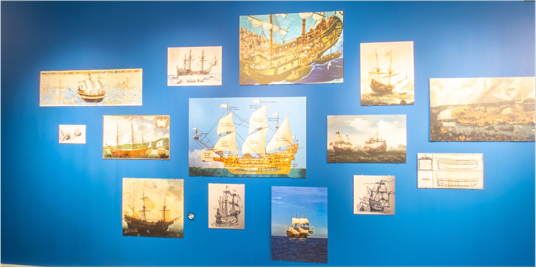
Muntadas identified three traded objects or presentés —the mantón de Manila or Manila Shawl, medallions and coins, and ceramics —as his subjective interpretations of connecting with the past and the present of the Philippines.
In Muntadas’ art practice, the idea of movement is a recurring concept, through the themes of “transnationality and globality,” encapsulated by the galleon trade in the 16th century and the circumnavigation of the globe that connected the East and the West. The movement of people led to exchanges of ideas, beliefs, inventions, languages, and social customs.
Malas hierbas
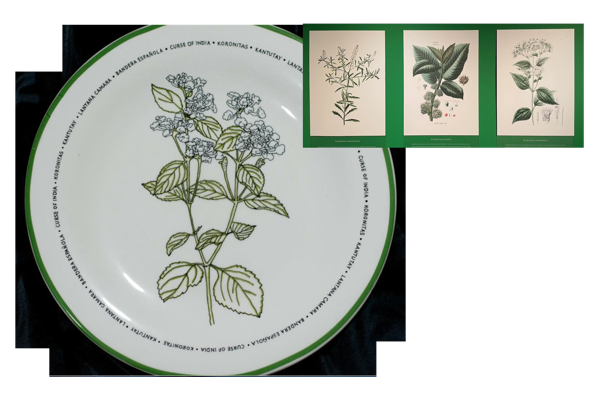
Diverse plants travelled to Manila, and in the exhibit, a set of nine ceramic plates portrays the invasive plants transported from the Americas through the galleons. Intentionally, the ceramic plates were manufactured in La Cartuja, Seville, the site of factories that produced ceramic ware for the galleon trade, highlighting the link between the two countries.
The design for each plate was based on historical botanical drawings such as Fr. Manuel Blanco’s Floras de Filipinas.
The invasive weeds with pretty flowers detrimental to the local ecosystem allude to the invasive effect of colonialism in the wiping out and marginalization of indigenous communities and their cultures in the country.
Mantón de Manila
Imported from China through Manila to Spain and Europe, the Mantón de Manila became part of popular culture in Spain as a fashionable accessory worn by women in bullfights as well as by flamenco dancers. As Muntadas notes, flamenco dancers were always photographed wearing the silk shawls.
Using the mantónes as canvas, 15 shawls have been elaborately embroidered with images that mark different points of Philippine history, popular culture, and current events. Included are the Edsa People Power Revolution, 1986; a political cartoon on Duterte’s drug war; the plight of the comfort women; Makapili collaborators during the Japanese occupation, World War II; Thrilla in Manila or the Muhammad Ali-Joe Frazier boxing match in 1975, the Balangiga Massacre, Samar, 1901; and the role of the anting-anting at the turn of the century.
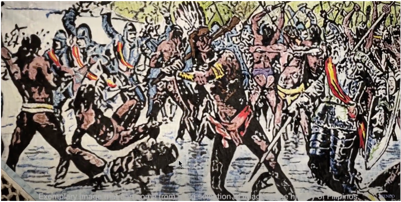
By doing so, the mantón is “decolonized and appropriated in local and contemporary terms,” making it truly a mantón de Manila.
The artisans of Lumban, Laguna embroidered the silk mantónes; its 16-inch-long fringes were done in India.
Human export: OFWs
Filipino workers remain anonymous, faceless, and only hit the headlines in stories of maltreatment and exploitation, such as falling to their deaths while cleaning high-rise windows in Hong Kong or running away from sexual abuse in Kuwait.
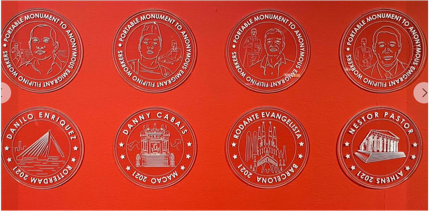
Muntadas honors the Filipinos working overseas through a different kind of commemorative coin.
Portable Monuments to Emigrant Filipinos features a set of ten coins honoring ten Filipinos working in ten cities around the world, from Barcelona, New York, Amman, to Macao. Selected by their own respective communities, the exhibit presents their personal stories and achievements.
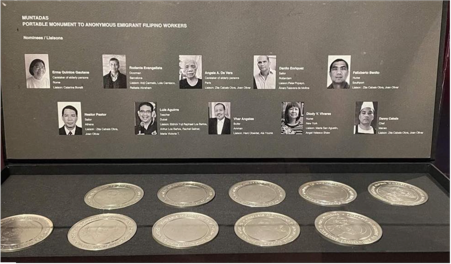
Muntadas regards the coins or medallions as monuments, albeit portable, and an act of recognition, making the invisible OFWs visible. Symbolic of the tribute that each coin represents, a portrait of the Filipino worker is on one side of the coin; and on the other side, a symbol of the city where he lives. The 10 Filipinos received their coins, much to their surprise and gratitude.
Minted in silver, the coins allude to the circulation of the metal during the colonial period, the enrichment of the Spanish Empire from its colonies, and now, the critical importance of OFW remittances to the Philippine economy.
Antoni Muntadas (Barcelona, b. 1942)
An acclaimed conceptual artist, Muntadas has lived in New York since 1971. The processes of mediation, transmission, and transport are concepts that he continuously explores in his art practice
Aside from having been exhibited in major museums around the world, he has taught in various institutions in Europe and the United States, including the National School of Fine Arts in Paris, the University of California in San Diego, the Art University in Tokyo, and the Massachusetts Institute of Technology in Cambridge, Mass.
Behind the exhibit
Despite many challenges posed by the global pandemic, two years of extensive research and production work took place between the AAG Manila team and the Spanish team for the first exhibit in late 2021. It went on to Centro Andaluz de Arte Contemporáneo (CAAC) in Seville, and in March 2023, the AAG has remounted the exhibit in Manila, once more.


